Method for producing fish gelatin peptide
a technology of gelatin and peptide, which is applied in the direction of peptides, immunoglobulins, peptide/protein ingredients, etc., can solve the problems of not being popular with consumers, and achieve the effect of simplifying the steps and significant elimination of the characteristic fish odor
- Summary
- Abstract
- Description
- Claims
- Application Information
AI Technical Summary
Benefits of technology
Problems solved by technology
Method used
Image
Examples
example 1
Screening of Various Pretreatments
[0024] About 5 g of Alaskan pollack skin was immersed in 50 ml of each one of the cleaning solutions as listed in Table 1 at room temperature for one hour, the cleaning solution was removed, and the skin was washed with water and then freeze-dried. The skin preparation was tested for its fish odor by simply smelling the sample. The evaluation results of the fish odor for various skin preparations were compared in terms of the cleaning solutions with which they had been washed, and the results are shown in Table 1 (the skin preparations were classified according to the fish odor they exhibited into the following categories: trace fish odor (+), slight fish odor (++), and notable fish odor (+++)).
TABLE 1Cleaning solutionEvaluation resultNo cleaning+++Water+0.5% salt water+1.0% salt water+5.0% salt water++ 10% salt water+++ 20% salt water+++0.1 N NaOH++0.1 N HCl+++
[0025] These results were taken as primary test results, and the skin preparations th...
example 2
Preparation of Gelatin Peptide from Alaskan Pollack Skin
[0027] A 100 g sample of Alaskan pollack skin was washed with 1 l of a 1.0% aqueous solution of NaCl, 0.5 l of a 1.0% aqueous solution of NaCl, 0.5 l of water, and 0.5 l of water in this order. Extraction was achieved by immersing the washed skin in 300 ml of water at 60° C. for one hour. The liquid extract was filtered, and 0.1 ml of alkalase (Novo Nordisk) was added to the filtrate and the mixture was incubated at 60° C. for 1.5 hours to obtain low molecular weight peptides. After enzyme digestion, the mixture was boiled for ten minutes to inactivate the enzyme. Precipitates in the sample solution thus obtained were removed by centrifugation and the solution was concentrated under reduced pressure. To the concentrate was added 1 g of activated carbon, and the mixture was stirred at room temperature for one hour and filtered by aspiration to remove the activated carbon. The filtrate was freeze-dried to give gelatin peptide. ...
example 3
Comparison of Pretreatments With or Without Exposure to Activated Carbon in Terms of the Quality of the Product
[0028] Skin samples were processed under the following conditions, and gelatin peptide products obtained therefrom were compared in terms of their quality. [0029] Condition 1: no washing of the skin sample and no activated carbon treatment [0030] Condition 2: washing of the skin sample (with 1% salt water and water), and no activated carbon treatment [0031] Condition 3: no washing of the skin sample, but with activated carbon treatment [0032] Condition 4: washing of the skin sample (with 1% salt water and water) and activated carbon treatment
[0033] The skin samples were otherwise treated in the same manner as in Example 2. The gelatin peptide preparations obtained as described above were dissolved in water to give a 10% aqueous solution. The fish odor of the test solutions was evaluated by simply smelling the solutions, and their color by spectroscopy. The evaluation res...
PUM
| Property | Measurement | Unit |
|---|---|---|
| temperature | aaaaa | aaaaa |
| temperature | aaaaa | aaaaa |
| Water-soluble | aaaaa | aaaaa |
Abstract
Description
Claims
Application Information
 Login to View More
Login to View More - R&D
- Intellectual Property
- Life Sciences
- Materials
- Tech Scout
- Unparalleled Data Quality
- Higher Quality Content
- 60% Fewer Hallucinations
Browse by: Latest US Patents, China's latest patents, Technical Efficacy Thesaurus, Application Domain, Technology Topic, Popular Technical Reports.
© 2025 PatSnap. All rights reserved.Legal|Privacy policy|Modern Slavery Act Transparency Statement|Sitemap|About US| Contact US: help@patsnap.com

